

Center for Food Safety. Are GMOs safe? Yes. The case against them is full of fraud, lies, and errors. Is genetically engineered food dangerous?
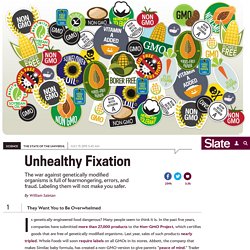
Many people seem to think it is. In the past five years, companies have submitted more than 27,000 products to the Non-GMO Project, which certifies goods that are free of genetically modified organisms. Are GMOs safe? No consensus in the science, scientists say in peer-reviewed stateme. Are GMOs safe?

No consensus in the science, scientists say in peer-reviewed statement Following GMO apple approval, consumer watchdog groups highlight need for accurate media coverage on GMO science WASHINGTON, D.C. – On the heels of USDA deregulation of the Arctic® apple -- the first genetically engineered apple -- leading consumer, food safety and environmental groups issued a response to widespread media reports wrongly characterizing the science on GMOs as settled.
The groups, including Consumers Union, Center for Food Safety, Friends of the Earth and Pesticide Action Network,pointed to a January 24 statement in the journal Environmental Sciences Europe -- signed by 300 scientists, physicians and scholars -- that asserts there is no scientific consensus on the safety of GMOs. The claim of scientific consensus on GMOs frequently repeated in the media is “an artificial construct that has been falsely perpetuated,” the peer-reviewed statement said. No scientific consensus gmo safety 2015 6pp. Historical control data final. Pluripotent Stem Cells, iPs cells. Controversies in Treatment Approaches: Gene Therapy, IVF, Stem Cells, and Pharmacogenomics. Bainbridge, J.

W. B., et al. Effect of gene therapy on visual function in Leber's congenital amaurosis. New England Journal of Medicine 358, 2231–2239 (2008) Actual Glow-In-The-Dark Pigs Created by Chinese Scientists. Every once in a while science comes up with something so amazing, so incredible, that the universe seems filled with wonder and possibilities.
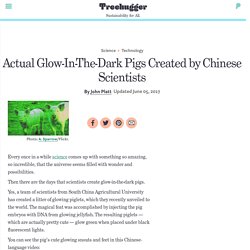
Then there are the days that scientists create glow-in-the-dark pigs. Yes, a team of scientists from South China Agricultural University has created a litter of glowing piglets, which they recently unveiled to the world. The magical feat was accomplished by injecting the pig embryos with DNA from glowing jellyfish.
Why is the Gates foundation investing in GM giant Monsanto? The Bill and Melinda Gates Foundation, which is sponsoring the Guardian's Global development site is being heavily criticised in Africa and the US for getting into bed not just with notorious GM company Monsanto, but also with agribusiness commodity giant Cargill.

Trouble began when a US financial website published the foundation's annual investment portfolio, which showed it had bought 500,000 Monsanto shares worth around $23m. This was a substantial increase in the last six months and while it is just small change for Bill and Melinda, it has been enough to let loose their fiercest critics. Seattle-based Agra Watch - a project of the Community Alliance for Global Justice - was outraged. "Monsanto has a history of blatant disregard for the interests and well being of small farmers around the world… [This] casts serious doubt on the foundation's heavy funding of agricultural development in Africa," it thundered.
Earth Open Source – Trusted science, shared solutions, sustainable food. GMO Myths and Truths 331pp 2014. Gm full eng v15. GMOs Don’t Feed the World. Feeding The World Without GMOs from Gringo Starr Productions on Vimeo.
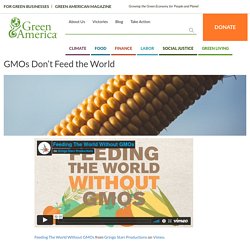
One of the most often touted benefits of genetically engineered (GE) crops [more commonly referred to as genetically modified organisms (GMOs)] is that they are essential to feed the world’s growing population. There are currently over 7.5 billion people on this planet and expected to rise to 9.5 billion by 2050. If consumption trends continue, in order to feed that many people, we would need to grow one-third more food. Genetically Modified Organisms (GMOs) Barta, A., et al.
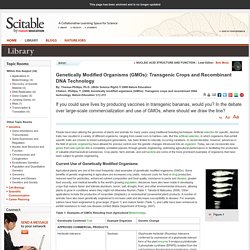
The expression of a nopaline synthase-human growth hormone chimaeric gene in transformed tobacco and sunflower callus tissue. Plant Molecular Biology 6, 347–357 (1986) Beyer, P., et al. Recovering the Original Intentions of Risk Assessment and Management of Genetically Modified Organisms in the European Union. Early Drafting of the GMO Regulations Progress in the field of recombinant nucleic acid techniques and cross-species gene delivery in the 1970s and 1980s prompted legislators in the European Union (EU) to develop biosafety regulations encompassing these techniques and their resulting products.
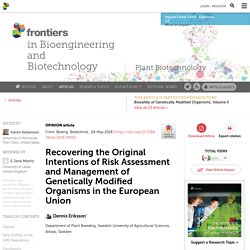
The ensuing procedure for risk assessment and risk management of genetically modified organisms (GMOs), as these were denominated, in the EU has thus been established with the purpose of ensuring a high level of protection of human health and the environment. The early draft legislative texts on GMOs in the EU (Commission of the European Communities, 1988) resulted in the first Council Directive on the deliberate release into the environment of GMOs (Dir 90/220/EEC) in 1990 (Official Journal of the European Communities, 1990).
Shifting Focus to Organisms and Their Traits. What is a GMO? – The Non-GMO Project. A GMO, or genetically modified organism, is a plant, animal, microorganism or other organism whose genetic makeup has been modified in a laboratory using genetic engineering or transgenic technology.
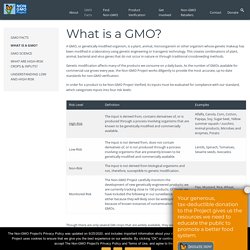
This creates combinations of plant, animal, bacterial and virus genes that do not occur in nature or through traditional crossbreeding methods. Genetic modification affects many of the products we consume on a daily basis. As the number of GMOs available for commercial use grows every year, the Non-GMO Project works diligently to provide the most accurate, up-to-date standards for non-GMO verification. GMO Facts – The Non-GMO Project. What is a GMO?

Genetically modified organisms (GMOs) are living organisms whose genetic material has been artificially manipulated in a laboratory through genetic engineering. This creates combinations of plant, animal, bacteria, and virus genes that do not occur in nature or through traditional crossbreeding methods. GMO Science – The Non-GMO Project. There is no scientific consensus on the safety of GMOs. According to a 2015 statement signed by 300 scientists, physicians and scholars, the claim of scientific consensus on GMOs frequently repeated in the media is “an artificial construct that has been falsely perpetuated.” To date, there have been no epidemiological studies investigating potential effects of GMO food on human health.
Most of the research used to claim that GMOs are safe has been performed by biotechnology companies. GMO Myths and Truths (3rd edition) – Earth Open Source. Book giving the scientific case against genetically modified crops and foods is for sale on Amazon and in Barnes & Noble and independent bookstores. 2 March 2016 GMO Myths and Truths, the scientific case against genetically modified (GM) crops and foods, is now available as a book in a condensed and updated version ( The first edition of GMO Myths and Truths was published in 2012 and the second in 2014 as free online pdf downloads. The 2014 version is still available for free on the Earth Open Source website. GMO Myths and Truths (2nd edition) – Earth Open Source. GMO debate is far from over Author John Fagan said: “The GMO debate is far from being over, as some GMO proponents claim. Viewable. Case studies: A hard look at GM crops. Superweeds? Suicides? Stealthy genes? The true, the false and the still unknown about transgenic crops.
Pay to View. A literature review on the safety assessment of genetically modified plants. In recent years, there has been a notable concern on the safety of genetically modified (GM) foods/plants, an important and complex area of research, which demands rigorous standards. Diverse groups including consumers and environmental Non Governmental Organizations (NGO) have suggested that all GM foods/plants should be subjected to long-term animal feeding studies before approval for human consumption.
In 2000 and 2006, we reviewed the information published in international scientific journals, noting that the number of references concerning human and animal toxicological/health risks studies on GM foods/plants was very limited. The main goal of the present review was to assess the current state-of-the-art regarding the potential adverse effects/safety assessment of GM plants for human consumption. A literature review on the safety assessment of genetically modified plants.
Monitoring GMO. Bioethics. Industrial Agriculture. Ingredients. Food Safety.